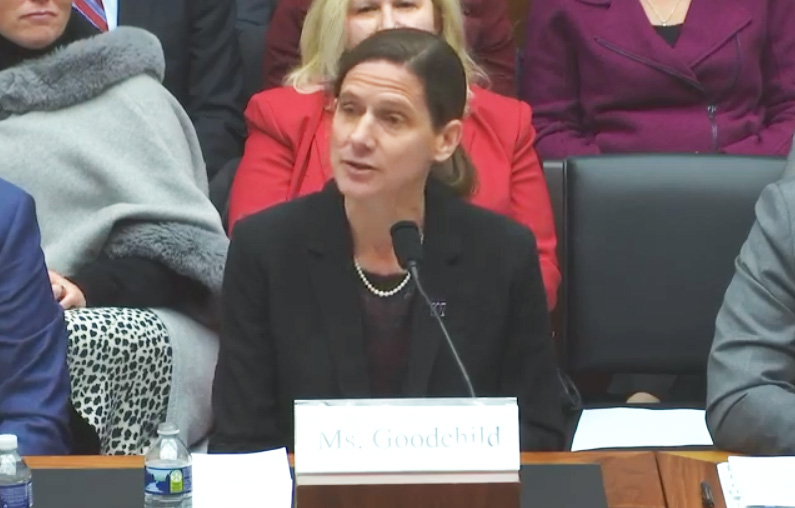
DECEMBER 5, 2019 — Supply Chain Transportation & Logistics Center Director Anne Goodchild provided testimony today to the U.S. House of Representatives Transportation and Infrastructure Committee, in a joint hearing of the Subcommittee on Highways and Transit and the Subcommittee on Railroads, Pipelines, and Hazardous Materials entitled “Where’s My Stuff? Examining the Economic, Environmental, and Societal Impacts of Freight Transportation.”
On the heels of Black Friday, Goodchild and other expert witnesses discussed goods movement in the U.S. and particularly the ways in which ecommerce is transforming supply chain logistics, urging members to consider greater investment in the freight network as they consider how to fund surface transportation projects over the next several years. The current surface transportation bill, the Fixing America’s Surface Transportation Act (FAST Act), is in effect through September 2020.
“Whether they realize it or not, shoppers who took advantage of Black Friday and Cyber Monday deals are relying on a vast and complex freight network to provide and deliver their purchases,” said Peter DeFazio (D-OR), Chair of the Transportation and Infrastructure Committee.
Members pointed out that Congress didn’t discuss e-commerce when it was reauthorizing the surface transportation bill four years ago.
Goodchild explained that the Final 50 Feet is the most difficult and costly segment of the supply chain, estimated at comprising 25-50% of total supply chain transportation costs, because: it relies on human labor, shipments are more fragmented, travel speeds can be unreliable and slow, and failed deliveries require additional trips.
“When we talk about freight infrastructure investment and building a better freight system, we must remember to include the last mile and particularly the Final Fifty Feet to the final delivery destination,” said Goodchild. “Without completing this final step, supply chains fail to deliver the economic and social benefits they promise.”
Goodchild stated that online shopping is growing in both popularity and delivery speed, putting pressure on retailers to meet customer expectations to ship increasingly faster without the time to consider efficiency.
“As customers are offered, and accept, shorter and shorter click-to-delivery times, delivery companies have less opportunity to make consolidated, efficient deliveries. Instead of waiting for more orders and sending out full trucks, vehicles are sent out to meet their quick delivery promise; reducing vehicle utilization. This increases the number of vehicles on the road, increases the cost per delivery, and increases vehicle emissions,” she said
Goodchild shared that city roads and sidewalks enable this last mile delivery. In Seattle, 87% of buildings in greater downtown do not have off-street parking or loading bays and must rely solely on curbs for freight access.
“Our cities were not built to handle the nature and volume of current freight activity and are struggling to accommodate growth,” she said. “At the same time, delivery of goods is just one of the many functions of our transportation networks. The same roads and sidewalks are also used by pedestrians, cyclists, emergency vehicles, taxis, ride hailing services, buses, restaurants, and street vendors, to name a few.”
Goodchild introduced the Urban Freight Lab (UFL) as successful innovative solution enabling cities and private partners to work together and design and test economically efficient solutions to these challenges. Under Goodchild’s leadership, the UFL is a coalition of private companies and public agencies who work together to identify and measure problems, and develop and pilot-test solutions that will provide benefits for a diverse group of public and the private sector stakeholders.
With private- and public-sector funding the UFL has:
- produced foundational research on the Final Fifty Feet of the supply chain
- developed and applied approaches to quantify urban freight infrastructure
- developed and applied approaches to measure infrastructure
- generated and tested approaches to reducing dwell time and failed deliveries in urban areas including common lockers
- developed and implemented an approach to measuring the volume of vehicles entering and exiting the City of Seattle
Moving forward, Goodchild said, if we want to maintain and grow our current shopping and delivery habits, we need to rethink how we use our streets, curbs, and sidewalks, and consider new modes, technologies, and operational innovations, such as electric assist cargo bikes, electric and hybrid vehicles, and new technologies such as robotics, artificial intelligence, and electronic curbs.
“Private companies are ready to test these innovations, and the US and state DOTs can play a role in supporting these tests and conducting evaluations.”
Watch the full hearing:
MORE:
Read Anne Goodchild’s written testimony
Behind the Scenes photos
In the Media:
Freight Waves: E-commerce poised to influence next surface transportation bill
About the Urban Freight Lab (UFL): An innovative public-private partnership housed at the Supply Chain Transportation & Logistics Center at the University of Washington, the Urban Freight Lab is a structured workgroup that brings together private industry with City transportation officials to design and test solutions around urban freight management.
About the Final 50 Feet Research Program: The Urban Freight Lab’s Final 50 Feet research program designs and tests solutions to improve delivery at the end of the supply chain—beginning at a load/unload parking space at the curb, in an alley, or in a private loading bay, and maneuvering through sidewalks, intersections, and building security, and ending with the final customer.
About the Supply Chain Transportation & Logistics Center: The Supply Chain Transportation and Logistics Center at the University of Washington is the go-to place to analyze and solve urban goods delivery, sustainability, logistic hubs and ports, and freight system performance management problems that overlay private and public spaces and control. Our work integrates in-depth consultation with industry and the public sector, transformative research, and executive education, and serves the powerful nexus of industry, transportation infrastructure, and policymakers.